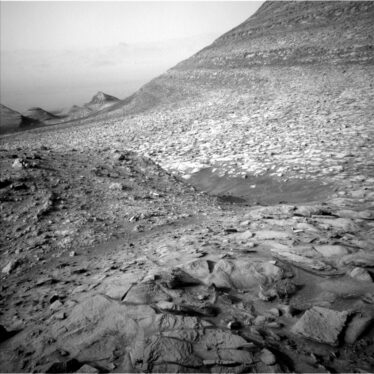3 min read
Sols 4184-4185: Look Near! Look Far!
Earth planning date: Monday, May 13, 2024
Today I’ve chosen to show off a spectacular image of ‘Texoli butte,’ but I’m rather biased in my assessment of its beauty because I am currently part of the team studying it. What continues to marvel me is Curiosity’s incredible suite of instruments that can not only help us to assess the rocks around us, but can be used to see very high detail of rocks hundreds of meters away – like Texoli butte – and today we took advantage of those superpowers!
ChemCam is looking far away for us over the next 2 sols, starting with a long-distance RMI of Texoli butte. On the second sol, we are looking at a structure further up Gediz Vallis channel that we won’t be driving up to named ‘Milestone Peak.’ The long-distance observations are really useful in ensuring we can see everything we need to, even if we don’t drive super close. We then take a glimpse between the buttes of Gediz Vallis and above the sulfate-bearing unit we are currently driving in to the yardang unit for the final long-distance RMI of this plan. We can also use Curiosity’s super vision to look at the atmosphere! Over the next 2 sols, Mastcam will measure the amount of dust in the atmosphere in a tau measurement, and Navcam will take a suprahorizon movie as well as being on the lookout for dust devils.
As well as really far away, Curiosity is a specialist at looking and taking measurements of rocks right in front of us. Curiosity will be taking APXS measurements and MAHLI observations on two nearby rocks named ‘Tenaya Lake’ and ‘Buck Lake.’ On the same rock as Buck Lake, ChemCam will be taking a LIBS measurement on a target named ‘Illilouette Falls,’ and another rock a little further away called ‘Redwood Canyon,’ as well as a passive observation on a dark-toned rock named ‘Cox Col.’ Mastcam will document these observations, as well as looking back at the south side of Pinnacle Ridge we have just driven around. In total, Mastcam will spend 1 hour documenting the rocks here at the Gediz Vallis Ridge, including a 15×3 mosaic during an early morning wake-up call at 07:30 to take advantage of the morning light on Mars.
The science team did a wonderful job today documenting all things near and far in this beautiful workspace. As the Keeper of the Plan for the Geology and Mineralogy theme group today, I really enjoyed helping to make this plan a reality, and I can’t wait to see all the fantastic images and data we get back from Mars.
Written by Emma Harris, Graduate Student at Natural History Museum
Share
Details
Related Terms
https://science.nasa.gov/blogs/sols-4184-4185-look-near-look-far/











